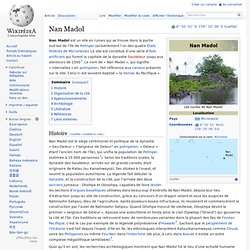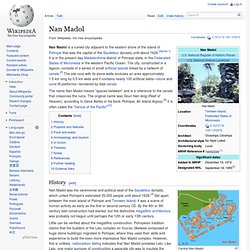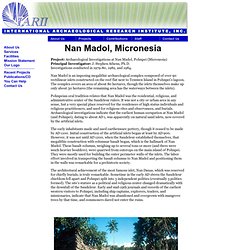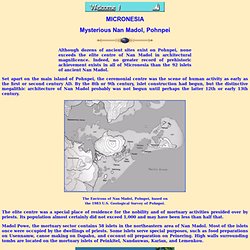

Photos Nan Madol. Nam Madol Google Maps. Nan Madol. Un article de Wikipédia, l'encyclopédie libre.

Histoire[modifier | modifier le code] Quoi qu'il en soit, les recherches archéologiques montrent que Nan Madol fut le lieu d'une activité humaine dès le premier ou le IIe siècle de notre ère. Au VIIIe siècle ou IXe siècle, la construction des îlots commence, mais l'architecture mégalitique n'a probablement pas commencé avant le XIIe siècle ou le début du XIIIe siècle. De la tradition orale, peu de choses peuvent être vérifiées sur la construction des mégalithes. Les architectes, eux, pensent que les orgues basaltiques ont été transportées par voie de terre roulées sur des troncs de cocotiers et par voie d'eau sur des flotteurs en profitant des marées hautes dans les canaux de la mangrove[4]. Organisation de la cité[modifier | modifier le code] Carte du centre de Nan Madol Selon les données archéologiques, Nan Madol a été un lieu de résidence pour la noblesse et d'activités funéraires présidées par des prêtres.
Sur les autres projets Wikimedia : L’énigme de Nan Madol — BIBLIOTHÈQUE EN LIGNE Watchtower. Ruines mégalithiques de Nan Madol: 1. Nan Madol - Inclassables de Histoire, Mythes & légendes. Nan Madol est un site de contruction mégalithique humaine remarquable, situé sur l'île de Ponhpei (île volcanique) dans le Pacifique, en Micronésie : Le site de Nan Madol se situe sur l'île de Tewmen rattachée à Pohnpei au sud(est.

Pohnpei est la plus grande île de Micronésie et à l'époque de sa découverte elle comptait pas moins de 30 000 résidents. Il n'en reste aujourd'hui que 200. L'hécatombe fut provoquée par l'arrivée de colons venus de l'ouest. Le site de Nan Madol est construit sur la côte rocheuse de l'île de Temwen avec nombres de colonnes en basalt. La plus proche région basaltique se trouve très loin (pas trouvé où). Chaque colonne a un poids variant de 20à 30 tonnes. certains ont essayé de transporter des colonnes de même types, mais la limite de flotaison d'une barge en bambou est de 1 tonne.
Nan Madol s'étend sur 1,5 Km de long et 500 m de large. Les bases des constructions ont été "plantées" sous l'eau, sous le niveau de l'eau. Vidéo avec pas mal d'images du site ; Nan Madol. The name Nan Madol means "spaces between" and is a reference to the canals that crisscross the ruins.

The original name was Soun Nan-leng (Reef of Heaven), according to Gene Ashby in his book Pohnpei, An Island Argosy.[9] It is often called the "Venice of the Pacific"[10] History[edit] Nan Madol Ruins. "In his house at R'lyeh, dead Cthulhu waits dreaming"

Nan Madol: The City Built on Coral Reefs. We zigzag slowly in our skiff around the shallow coral heads surrounding Pohnpei.

The island, a little smaller than New York City, is part of the Federated States of Micronesia. It is nestled in a vast tapestry of coral reefs. Beyond the breakers, the Pacific stretches 5,578 miles to California. A stingray dashes in front of us, flying underwater like a butterfly alongside our bow. Our destination is Nan Madol, near the southern side of the island, the only ancient city ever built atop of a coral reef. Abandoned centuries ago and now mostly covered with jungle, Nan Madol may soon be getting a makeover. We nuzzle up to land and jump onto the remnants of a sea wall. Aside from Easter Island, Nan Madol is the main archaeological site in Oceania that is made up of huge rocks.
“Nan Madol is one of the most significant sites not yet on the World Heritage List,” says Richard Engelhart, an archaeologist and former Unesco adviser for Asia and the Pacific. Sadly, neither do I. Nan Madol. Nan Madol High thermal mass architecture does have historic precedent in Micronesia.

The ruins of Nan Madol are good examples of this. Built on the southeastern end of Pohnpei, they were constructed over a period of 1000 years, from 500 AD to the mid 1500’s. It is not known whether the original builders considered the advantage of a high thermal mass assembly cooled through conductivity and evaporation via the surrounding ocean water, when they chose this method of construction. They were probably more concerned with durability and defense. Today there is an understanding of the concept of cooling through the use of shaded thermal mass. Nan Madol. View of Nan Dauas islet, reserved for Saudeleur burials, with its graceful walls built of columnar basalt.

Close-up of columnar basalt wall construction at Nan Dauas. The central burial vault at Nan Dauas. The slender basalt columns covering the burial vault are each about 5 meters long. Project: Archaeological Investigations at Nan Madol, Pohnpei (Micronesia)Principal Investigator: J. Stephen Athens, Ph.D. La cité ancienne de Nan Madol. La cité ancienne de Nan Madol - 01-2012 - updated 04-2015 Nan Madol est une ville en ruine qui se trouve dans la partie sud-est de l'île de Pohnpei (actuellement l'un des quatre États fédérés de Micronésie).

C'est un site constitué d'une série d'îlots artificiels qui fut la capitale de la dynastie Sau Deleur jusqu'aux alentours de 1500. Mysterious City of Nan Madol - Archeology. Civilisations perdues Nan Madol. The Mysterious Nan Madol.

A short distance off the coast of the remote Micronesian island of Pohnpei lies one of the greatest archeological mysteries in the world, the Lost City of Nan Madol. Built on an ancient coral reef and covering more than 11 square miles, this ancient city is made up of hundreds of artificial islets, intersected by numerous manmade canals. Even more curious, many of the city’s larger islands are connected by submerged tunnels. The Mystery Behind the Ancient Stone City of Nan Madol. MYSTERIOUS NAN MADOL. Mysterious Nan Madol, Pohnpei Set apart on the main island of Pohnpei, the ceremonial centre was the scene of human activity as early as the first or second century AD.

By the 8th or 9th century, islet construction had begun, but the distinctive megalithic architecture of Nan Madol probably was not begun until perhaps the latter 12th or early 13th century. Nan Madol: le trésor secret des Pacific501 Places. Approaching Nan Madol by boat there is little sense of the scale of the ruins that are about to surround us. The choppy waves of the Pacific subside as we make our way through narrowing mangrove channels until finally we see the first basalt columns above the clear water. A moment later there is no doubt the size of this ancient site, sitting to the south-east of the Micronesian island of Pohnpei. Nan Madol is probably the world’s most important historical treasure not to have been added to the UNESCO World Heritage list.
Facts and legends about Nan Madol merge freely, leaving those looking for knowledge about the site unsure what to accept. What is known for sure is the foundations for the site were constructed in the 8th or 9th centuries AD, with the striking architecture being built around the 13th century. The Gold of The Gods - 04. 4 - Temuen, The Island They Call Nan Madol The Caroline Islands form the largest archipelago in Micronesia; there are more than 500 of them, with a total area of 617 square miles. With its 183 square miles, Ponape is the biggest of the Caroline Islands, three times as big as the Principality of Liechtenstein and with roughly the same population of 18,000 inhabitants.
The climate is tropical and most of the island is mountainous and uninhabitable. Ponape is surrounded by a girdle of other islands, islets and coral reefs. One of the tiny islands, about as big as the Vatican City, is called Temuen, according to the atlas. Engineering Marvel: The Mysterious Ruins of Nan Madol. Engineering Marvel: The Mysterious Ruins of Nan Madol Article by Steph, filed under Destinations & Sights in the Travel category. The only ancient city ever built upon a coral reef, Nan Madol is a marvel of ancient engineering so complex, no one can figure out how it was conceived and built starting in the 8th or 9th century CE.
The Lost City Of Nan Madol. The Lost City Of Nan Madol Nan Madol has never been "lost" as the title of this item implies, but this fantastic complex of 92 artificial islets sees few tourists. Located on Pohnpei (formerly spelled "Ponape") in Micronesia, Nan Madol lacks the well-publicized glamour of the Pyramids and Chichen Itza. If Nan Madol is not glamourous, it is certainly incongruous. Who would expect such huge stone structures to rise in the middle of nowhere? Dans le dédale de Nan Madol.